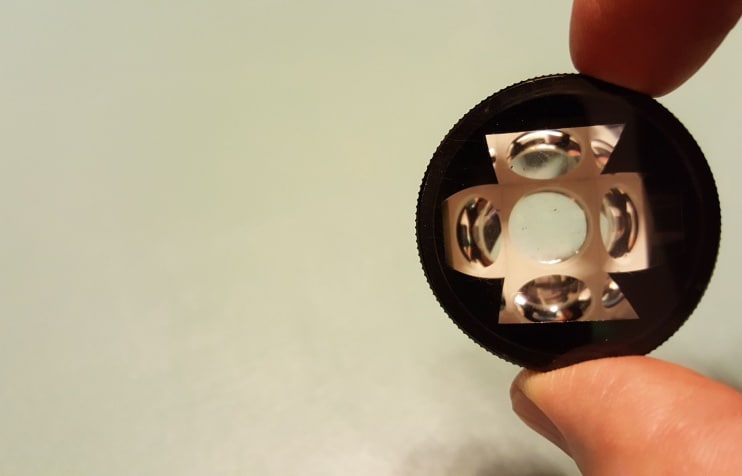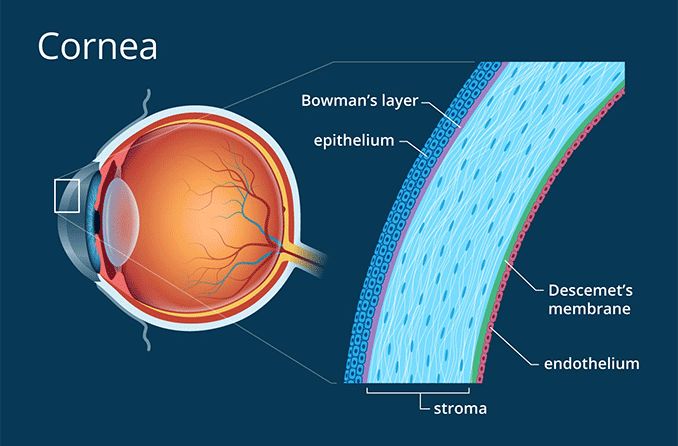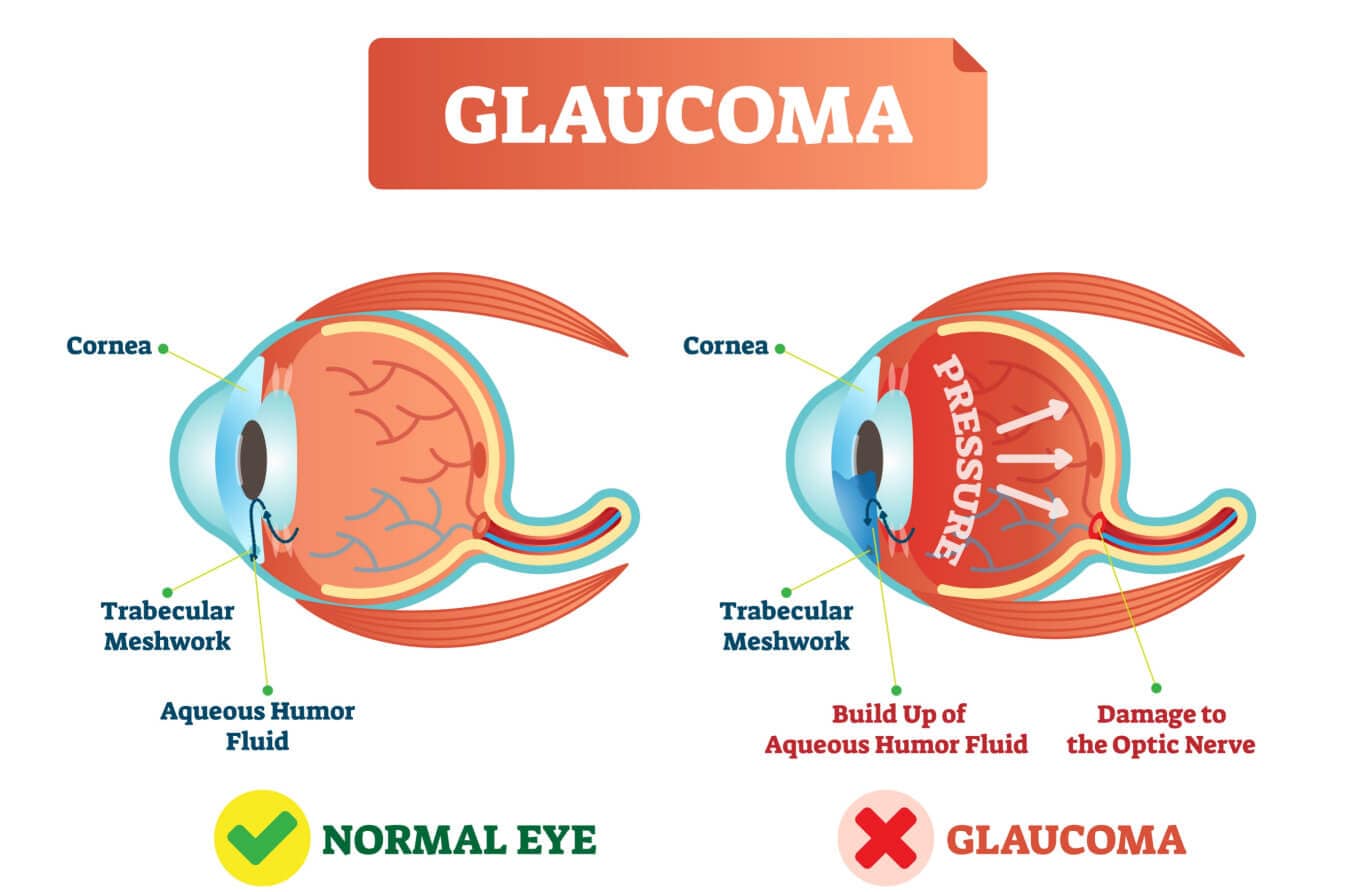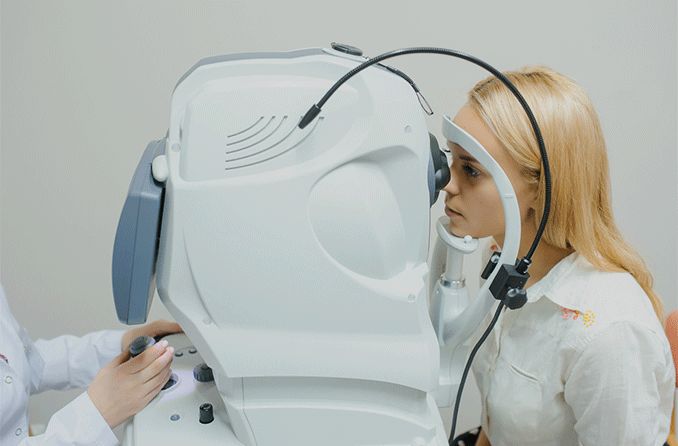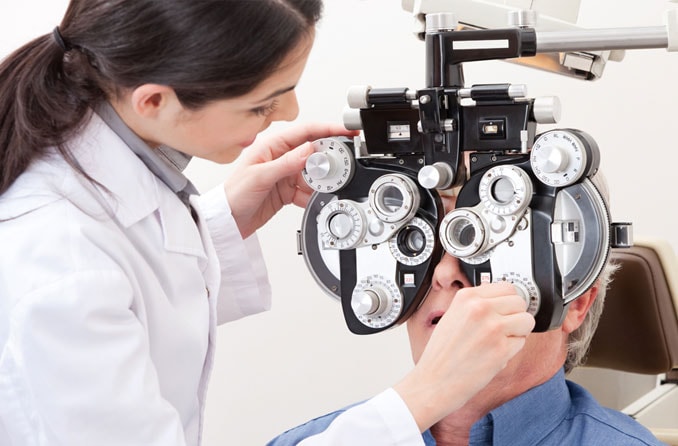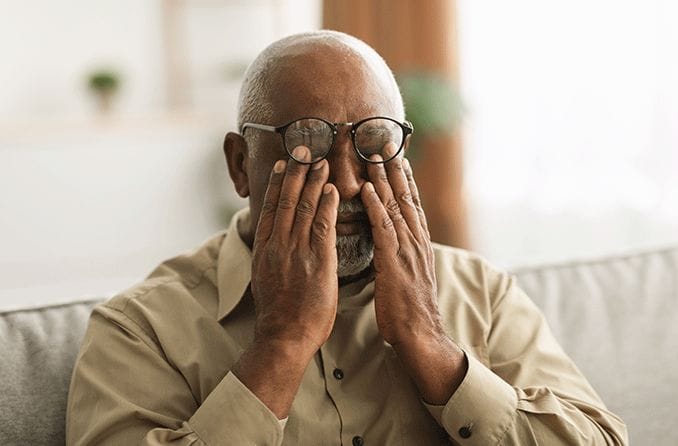What is gonioscopy?
Gonioscopy (go-nee-AH-skuh-pee) is a test that eye doctors use to look at the drainage angle near the front of your eye. It helps them understand your risk for developing glaucoma, a serious eye disease that can harm your vision if it isn't properly managed.
Gonioscopy also helps doctors diagnose and monitor eye conditions that can cause damage similar to glaucoma if left untreated.
While an eye doctor can't diagnose glaucoma or other conditions with a gonioscopy test alone, it's an important part of the process.
Why do eye doctors need to check the drainage angle?
Problems with the drainage angle can cause eye conditions that threaten your eyesight. Tests like gonioscopy help diagnose these problems so you can start treatment.
The drainage angle helps regulate your eye pressure by allowing a clear fluid called aqueous humor to drain out of your eye. This drainage occurs at the point where the cornea (the eye’s clear front layer) meets the iris (the colored part of the eye). The cornea and iris meet in a fluid-filled pocket called the anterior chamber.
An important part of the drainage angle is the trabecular meshwork. Most aqueous fluid has to pass through this spongy tissue on its way out of your eye and into your circulatory system. If the drainage angle is too narrow or if there's a problem with the meshwork, the fluid can back up and build pressure inside your eye.
High eye pressure puts you at risk for damage to the optic nerve, the connection between the eye and brain. This optic nerve damage is a defining feature of glaucoma.
An eye doctor can see all of the eye’s drainage angle structures and more during a gonioscopy. They can also check your optic nerve and eye pressure during your eye appointment. With the help of tests like gonioscopy, early glaucoma detection can save your eyesight.
Who might need a gonioscopy?
Eye doctors may recommend a gonioscopy for people who:
- Have high eye pressure
- Don't have glaucoma but could develop it soon (glaucoma suspects)
- Have had eye trauma
- Are very nearsighted (high myopia) or very farsighted
- Have other eye or health conditions that raise the risk for glaucoma
- Use medications that can increase glaucoma risk
- Have a higher glaucoma risk due to age, genetics, family history or other factors
- Have a problem with the blood circulation of the eye
- Have other concerning signs or symptoms that could suggest glaucoma or a related condition
Gonioscopy is also used for babies who have birth defects or other factors that raise their risk for glaucoma.
The gonioscopy procedure
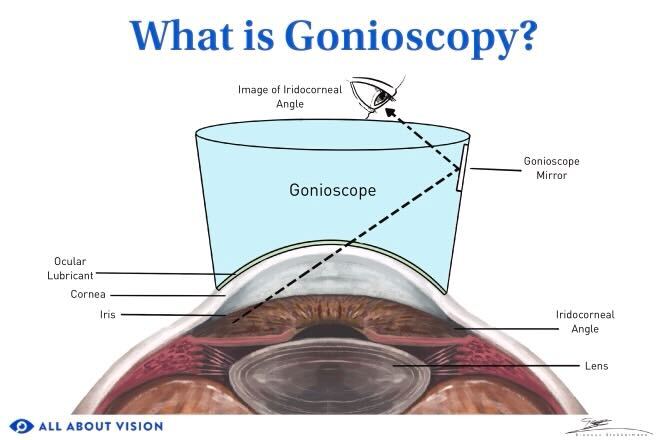
In most cases, gonioscopy can be done during an eye exam in the eye doctor's office. To prevent any discomfort, the patient’s eyes are numbed in advance with a topical anesthetic. The test itself only takes a few minutes.
Both ophthalmologists and optometrists are trained to perform gonioscopy as part of a glaucoma-focused eye exam.
Types of gonioscopy
There are two main types of gonioscopy: indirect and direct.
In an indirect gonioscopy, the doctor examines the drainage angle using a lens with mirrors attached. This is the test most people have in their eye doctor's office.
Your eye doctor may employ dynamic gonioscopy during an indirect gonioscopy. This involves gently pressing on your eye with the lens tool. This helps the doctor see if the iris separates from the cornea or lens when they press down.
In a direct gonioscopy, the doctor examines the eye with a magnifying lens placed directly on the eye. This test isn't used very often. It usually only happens in a hospital, often under anesthesia. For example, direct gonioscopy might be used during glaucoma surgery or when a baby is checked for a condition like congenital glaucoma.
How gonioscopy works
When you have an indirect gonioscopy test, your eye doctor will usually:
- Numb your eyes – As you sit in an exam chair, your eye doctor will apply numbing drops to your eyes so you don't feel any discomfort. They may also instill artificial tears or gel drops afterward.
- Ask you to move into position – You'll be asked to place your chin in a chin holder to help keep your head still.
- Place the gonioscope – The eye doctor will gently place the gonioscopy lens onto your eye and hold it there with one hand. You may feel mild pressure.
- Check the drainage angle – With their other hand, the eye doctor will shine a bright light through the lens. This is when they check the drainage angle for anything unusual.
- Examine your other eye – The doctor will repeat steps 3 and 4 on the other eye.
- Finish the test – The doctor removes the lens tool from your eye then tells you when you can remove your chin from the chin rest and relax.
Preparing for gonioscopy
You usually don't have to do anything to prepare for an in-office gonioscopy because it's a relatively simple test. But, if you wear glasses or contact lenses, the doctor will ask you to remove them beforehand.
Understanding your results
Your gonioscopy results give your eye doctor important information about your eyes and how they function. In particular, the test provides data regarding your risk for glaucoma and other conditions that could affect your eye pressure.
Interpreting gonioscopy results
After the gonioscopy, your eye doctor can tell you:
- If the drainage angle is too narrow
- If the drainage angle is at risk of becoming blocked or closed
- How well the drainage angle is functioning
They'll also tell you about any other signs of a possible problem. This information can help them diagnose or rule out certain conditions and issues, including:
- Narrow-angle glaucoma (angle-closure glaucoma) – When the drainage angle is too narrow or closed
- Open-angle glaucoma – When the angle is open but drainage is still too slow, causing eye pressure to increase slowly over time
- Normal-tension glaucoma – When the angle is open and eye pressure is normal
- Pseudoexfoliation – When protein fiber clumps develop in the eye and clog the drainage angle
- Pigment dispersion syndrome – When tiny pieces of pigment come off the iris and block the drainage angle
- Neovascular glaucoma – When blood vessels in the drainage angle grow in an unusual way and slow or block the drainage of aqueous fluid
- Eye tumors – These growths in the eye can affect drainage in different ways
- Eye injuries – Trauma can cause changes inside the eye, which can in some cases lead to angle-recession glaucoma
If your results aren't within the standard range, your doctor will talk to you about next steps. Depending on their findings, they may recommend additional tests, routine eye monitoring, and/or treatment.
Risks and complications
There aren't any risks or side effects from a gonioscopy, but your eyes may tear up a little.
Some people experience temporary side effects from the numbing eye drops used before the test, such as:
- Blurry vision
- Eye redness
- Watery eyes
- Light sensitivity
- A stinging sensation in your eyes
- A feeling of numbness in or near your nose
As with other eye drops, there's a very small risk that the numbing drops could give you an eye infection or allergic reaction. You can ask your eye doctor about this during your exam.
Alternatives to gonioscopy
While gonioscopy is a common way to check your drainage angle, eye doctors can also use other tests to examine that area. They include:
- Anterior segment optical coherence tomography (OCT) – A contactless test that uses light waves to make cross-section images the drainage angle
- Ultrasound biomicroscopy (UBM) – A test that uses sound waves to make cross-section images of the drainage angle
Frequently asked questions
Here are the answers to some of the most common questions about gonioscopy:
Does a gonioscopy hurt?
No, gonioscopy should not hurt. Your doctor will numb the surface of your eyes so you don't feel any discomfort. However, the numbing eye drops may cause a slight stinging sensation for a few moments.
Can you drive after a gonioscopy?
Yes, you can drive after an in-office gonioscopy since it doesn't affect your vision.
But your eye doctor may advise you not to drive if they also performed a dilated eye exam during the appointment. Dilating drops can make your vision blurry and sensitive to light for a few hours.
What's the difference between gonioscopy and tonometry?
Gonioscopy is used to check the status of your eyes’ drainage angles, while tonometry measures your eyes’ internal pressure. The "puff-of-air" test you’ve likely gotten during a past eye exam is one type of tonometry.
Is gonioscopy part of a routine eye exam?
No, gonioscopy is not part of a typical appointment, but your eye doctor will check your eye pressure and optic nerves during a routine comprehensive eye exam.
If any glaucoma-related abnormalities or risk factors are detected during the exam, your eye doctor may refer you to a glaucoma specialist for a gonioscopy and other testing.
If it’s been more than a year since your last appointment, it’s time to schedule an eye exam. Annual exams can lead to earlier diagnosis and treatment of glaucoma and other serious eye diseases. They can help keep your vision clear and your eyes protected.
